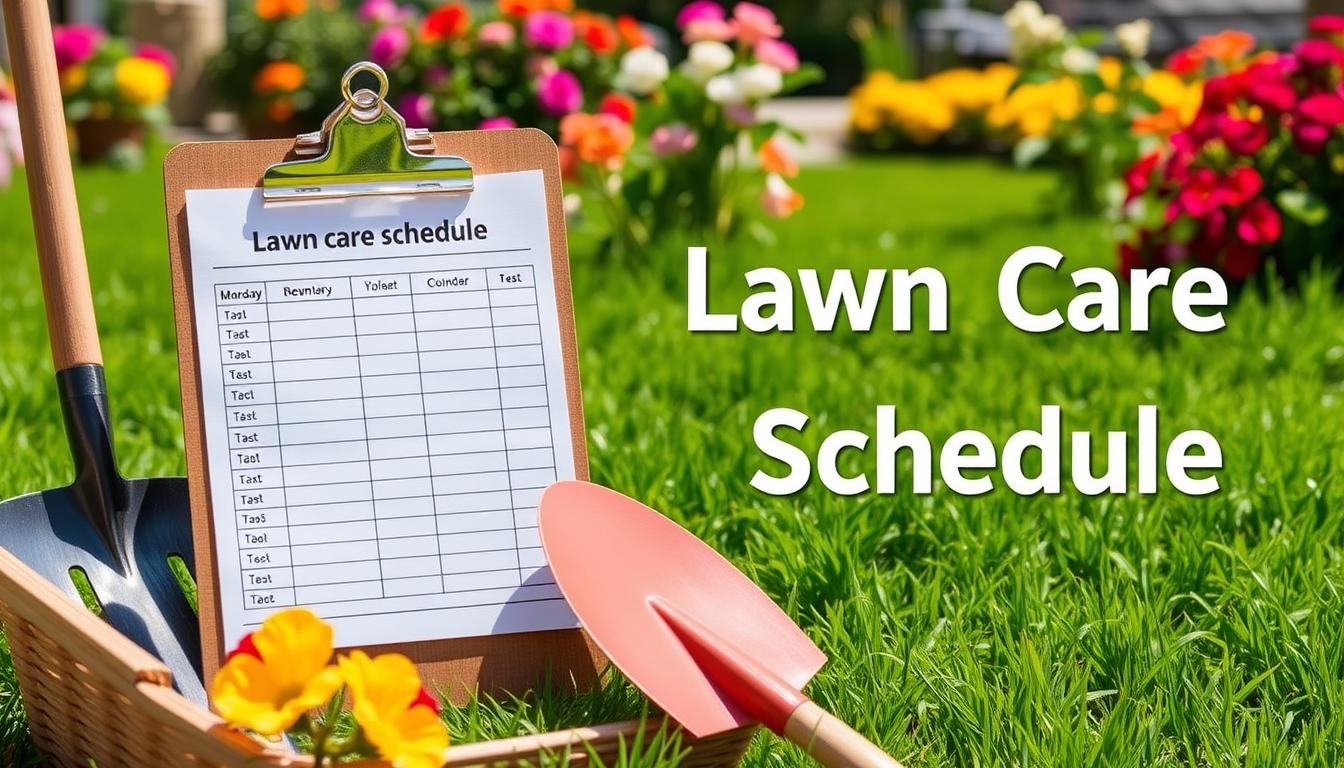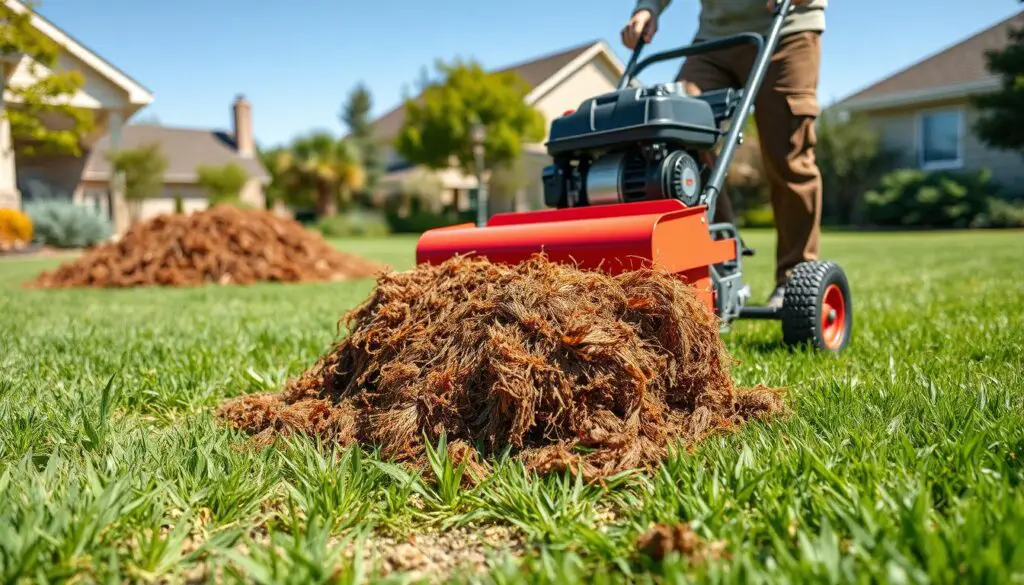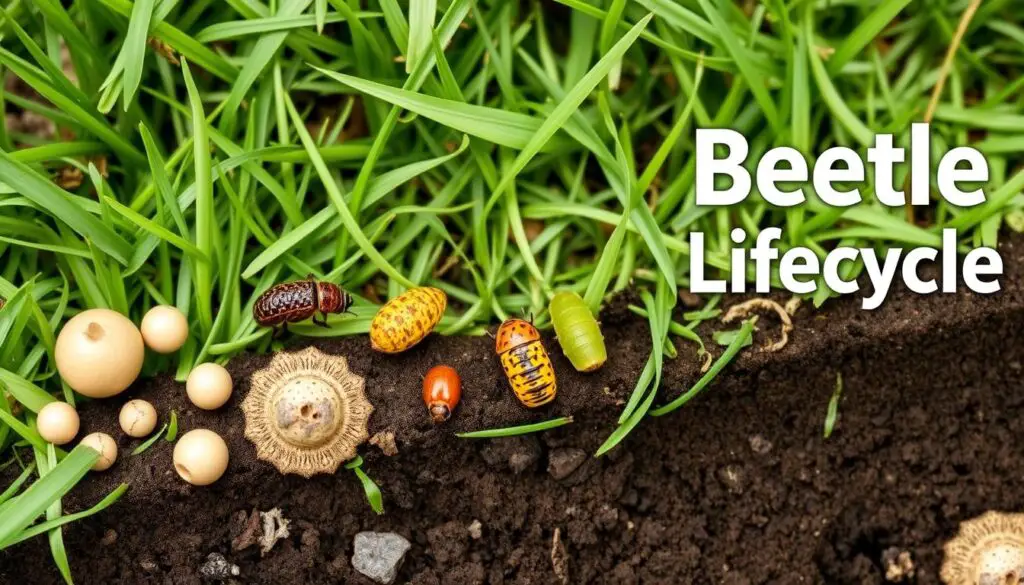How to Create a Lawn Care Schedule

Did you know the average American household spends over $500 a year on lawn care?
With a good lawn care schedule, you can save money and time. You can keep your yard looking great all year with a seasonal plan.
To have a healthy, lush lawn, you need a schedule for seasonal tasks. A lawn care schedule helps your yard stay green and vibrant all year. This guide will show you how to make the best lawn care schedule for your grass type and climate.
Key Takeaways
- Develop a comprehensive lawn care schedule to keep your yard in top shape
- Identify your grass type to tailor your lawn care plan according to it
- Perform essential spring tasks like raking, fertilizing, and mower prep
- Aerate and dethatch your lawn to promote healthy root growth
- Apply pre-emergent herbicides to control weeds before they sprout
- Implement a strategic mowing and watering routine for summer success
- Monitor and treat for grub infestations in warm-season grasses
Identify Your Grass Type
The first step in creating an effective lawn care schedule is to identify the type of grass in your yard. Knowing your grass type is key, as cool-season and warm-season grasses need different care. Tailor your lawn care plan to ensure your lawn thrives.
Cool-Season Grasses
Cool-season grasses are best for the northern half of the United States. They love cool, humid climates and grow well in temperatures between 60-80°F. Kentucky bluegrass, perennial ryegrass, and tall fescue are popular types. These grasses are lush, green, and can handle cooler temperatures, making them great for northern lawns.
Warm-Season Grasses
Warm-season grasses thrive in the southern half of the country. They prefer warmer, drier conditions and grow best in temperatures between 80-95°F. Bermuda grass, St. Augustine grass, and zoysia grass are common types. They’re perfect for southern climates because they handle heat and drought well.
| Cool-Season Grasses | Warm-Season Grasses |
|---|---|
| Kentucky Bluegrass | Bermuda Grass |
| Perennial Ryegrass | St. Augustine Grass |
| Tall Fescue | Zoysia Grass |
| Fine Fescue | Centipede Grass |
| Bentgrass | Bahia Grass |
Understanding the differences between cool-season and warm-season grasses helps you make better lawn care choices. This knowledge lets you create a lawn care schedule that’s perfect for your climate and grass type. It ensures your grass stays healthy and thrives all year round.
Spring Lawn Care Tasks
As winter fades and spring arrives, it’s time to focus on the lawn. This period is key for a lush, healthy grass landscape. Let’s explore the essential spring lawn care tasks to get your yard ready.
Rake and Clean Up
Begin by raking the lawn to clear leaves, dead grass, and debris from winter. This step lets sunlight and air reach the soil, helping grass grow. Be careful not to harm the new grass blades.
Test Soil and Fertilize
Then, test your soil’s pH and nutrient levels. This info helps choose the right fertilizer for your lawn. Use the right spring lawn fertilizer to feed your grass. Cool-season grasses might need early spring fertilizer, while warm-season grasses might do better later.
Prepare Lawn Mower
Before the first mow, service your lawn mower. Sharpen blades, change oil, and do any needed tune-ups. A well-maintained mower cuts grass evenly and reduces lawn stress.
By doing these spring lawn care tasks, you’ll prepare for a lush, vibrant lawn. Remember, paying attention to detail and regular maintenance are crucial for a beautiful outdoor space.

Aerate Lawn
Keeping your lawn healthy and lush is key, and aerating is a must. Lawn aeration makes small holes in the soil. This helps with soil compaction and improves how your grass roots get air, water, and nutrients.
In Texas, the soil types vary a lot. Sandy soils in places like Corpus Christi might only need aeration once a year. But, clay-heavy soils in Austin and San Antonio need it twice a year. Chalky soil in West Texas, from El Paso to Midland, also benefits from biannual aeration.
There are two main ways to aerate your lawn: liquid aeration and mechanical aeration. Mechanical aeration, or core aeration, is more effective. It physically removes small soil plugs, letting air, water, and nutrients reach deeper. You can do it yourself or hire a pro, with costs around $145 for a typical home.
When to aerate is just as important. For warm-season grasses like Bermudagrass and Zoysiagrass, aerate between May and September. Cool-season grasses like fescues and Kentucky bluegrass do best between September and November or March and April.
By aerating your lawn at the right time and using the right method, you can help your grass grow deeper roots. This improves soil structure and boosts your lawn’s health and strength. This simple step can make your lawn look vibrant and lush.
Control Thatch Buildup
Keeping your lawn healthy means watching out for too much lawn thatch. Thatch is a mix of living and dead plant material. It forms between the grass and the soil. Too much thatch can harm your lawn.
Dethatching Techniques
Regular dethatching is crucial to manage thatch. You can use a dethatching rake or a power dethatcher to remove it. Aim for a thatch layer less than half an inch thick.
Preventing thatch buildup is important. Things like too much fertilizer, compacted soil, and bad mowing can cause it. Changing your lawn care habits can help reduce the need for dethatching.
- Aerate your soil often to help air and water get in.
- Mow your lawn at the right height, cutting no more than one-third of the blade at once.
- Fertilize in the fall to help break down thatch.
- Use pesticides carefully, as they can harm the microbes that break down thatch.
Using these dethatching methods can keep your lawn looking great. It prevents the buildup of harmful lawn thatch.

“A thin layer of thatch provides insulation against temperature extremes and fluctuations in soil moisture, but excessive buildup can prevent air, water, and nutrients from reaching the grass roots.” – Sam, lawn expert
Apply Pre-Emergent Herbicides
As a homeowner, using pre-emergent herbicides is a great way to keep your lawn looking good. These products stop weed seeds from growing, keeping your grass healthy. By applying them at the right time, you can stop crabgrass and other weeds before they start.
Apply pre-emergent herbicides when the soil is around 55-60°F, usually in early spring. This is when summer annual weeds like crabgrass grow best. For winter annuals, like annual bluegrass, apply in late summer or early fall.
- Liquid pre-emergent herbicides are quickly absorbed, covering large areas fast.
- Granular formulas are more affordable and effective for preventing seed germination.
It’s important to follow the instructions on the product label for how much to use and when to water. Liquid pre-emergents need about 2 ounces per 1,000 square feet. Granular formulas need 0.5 inches of water or rain within 21 days to work.
“Pre-emergent herbicides are a powerful tool in the lawn care arsenal, but they work best when paired with healthy lawn maintenance practices.” – Sam, author of the blog
Keep in mind, pre-emergent herbicides only prevent new weeds from growing. They don’t kill existing weeds or seeds. So, make sure to keep your lawn healthy with good air, proper fertilization, and regular mowing.
Prevent Grub Infestations
Grubs, the larval stage of Japanese beetles, can harm your lawn by eating grass roots. This leaves dead patches. To stop grub damage, apply a preventive grub control product in late spring or early summer. This is crucial for cool-season grasses, which grubs like more.
Grub Control for Cool-Season Grasses
Signs of grub damage include a spongy lawn and animals digging. Curative treatments can fix this damage. But, to keep your lawn safe, get a preventative treatment for next year.
Getting lawn care services like fertilization, aeration, and overseeding helps your lawn recover. Sharp Lawn Care offers grub control services in Sioux Falls, SD, and nearby areas.
| Treatment Option | Active Ingredient | Application Rate | Cost per 1,000 sq ft |
|---|---|---|---|
| Hi-Yield Grub Free Zone III | Imidacloprid (0.5%) | 1.5 lbs per 1,000 sq ft | $5.91 |
| Curative Treatments | Dylox (trichlorfon), beta-Cyfluthrin, or carbaryl | Varies | Varies |
The best time to prevent grub infestations is in late May or June. Grubs eat turf roots and organic matter in their first instar stage. Most damage happens in August as they grow fat for winter.

By September, most larvae will have molted to the third instar. They go 8-10 inches deep to survive winter. Imidacloprid, used in preventative treatments, lasts about 90 days in the soil.
“Identifying grub damage early is key to preventing extensive harm to your lawn. Finding more than five grubs per square foot indicates a significant infestation that can damage your lawn.” – Richard, ecology professional
Curative options like Dylox, beta-Cyfluthrin, or carbaryl are used in September, October, or November. Products with both preventative and curative components can be used in July or early August if applied in time.
Mowing and Watering During Summer
Summer brings heat, and keeping your lawn green is a challenge. Whether your grass is cool-season or warm-season, the right care can help it survive the heat.
Cool-season grasses like fescue or Kentucky bluegrass need a higher mowing height, 3-4 inches. This helps them hold onto moisture and fight weeds. Warm-season grasses, such as Bermuda or Zoysia, do better at 2-3 inches, promoting dense growth.
It’s important to water your lawn deeply but not too often. Aim for about 1 inch of water per week, from rain or irrigation. This encourages deep roots, making your lawn more drought-resistant. Water every 3-4 days, for at least an hour, depending on the weather.
Keeping your mower blades sharp is key in summer. Dull blades can harm your grass, making it more susceptible to disease. Sharpen the blades after 25 hours of use for a clean cut.
By mowing and watering correctly, your lawn can stay lush and green all summer. Follow these tips to keep your grass healthy and vibrant.
| Grass Type | Mowing Height | Watering Frequency |
|---|---|---|
| Cool-Season Grasses | 3-4 inches | 1 inch per week |
| Warm-Season Grasses | 2-3 inches | 1 inch per week |
For a beautiful summer lawn, find the right balance between mowing and watering. These guidelines will help your grass look its best, even in the hottest months.

“Proper mowing and watering techniques are crucial for maintaining a healthy lawn during the hot summer months.” – Sam, lawn expert
Treat Warm-Season Grasses for Grubs
Cool-season grasses might face grub damage in spring. But warm-season grasses are more at risk in summer. To keep your warm-season lawn safe, apply grub control in early summer. Follow the product label instructions carefully.
This step prevents grubs from harming the grass roots. It also stops dead patches from appearing later.
Grasses like Bermudagrass, Zoysia, and Bahiagrass are common in southern areas. They are more likely to suffer from grub damage. July is the best time to use chemical grub control, as that’s when beetles lay eggs.
Treating your lawn when grubs are small and near the surface helps a lot. This way, you can reduce the damage they do.
Lawn care is about keeping your lawn healthy and looking good. Watch out for grub infestations in your warm-season grass early. This helps keep your outdoor space beautiful and lasting.

